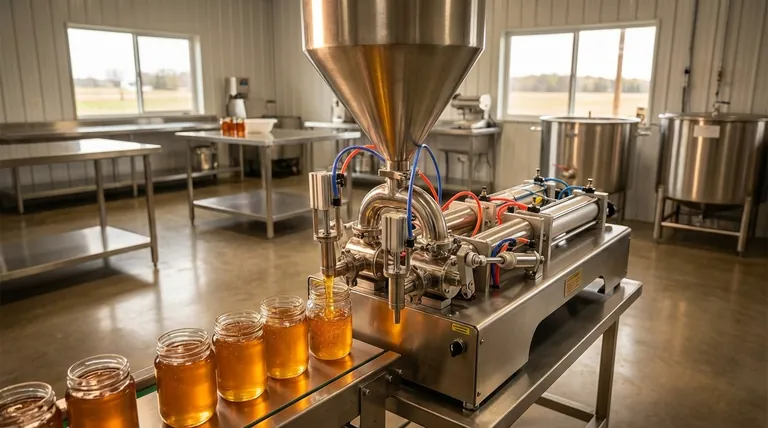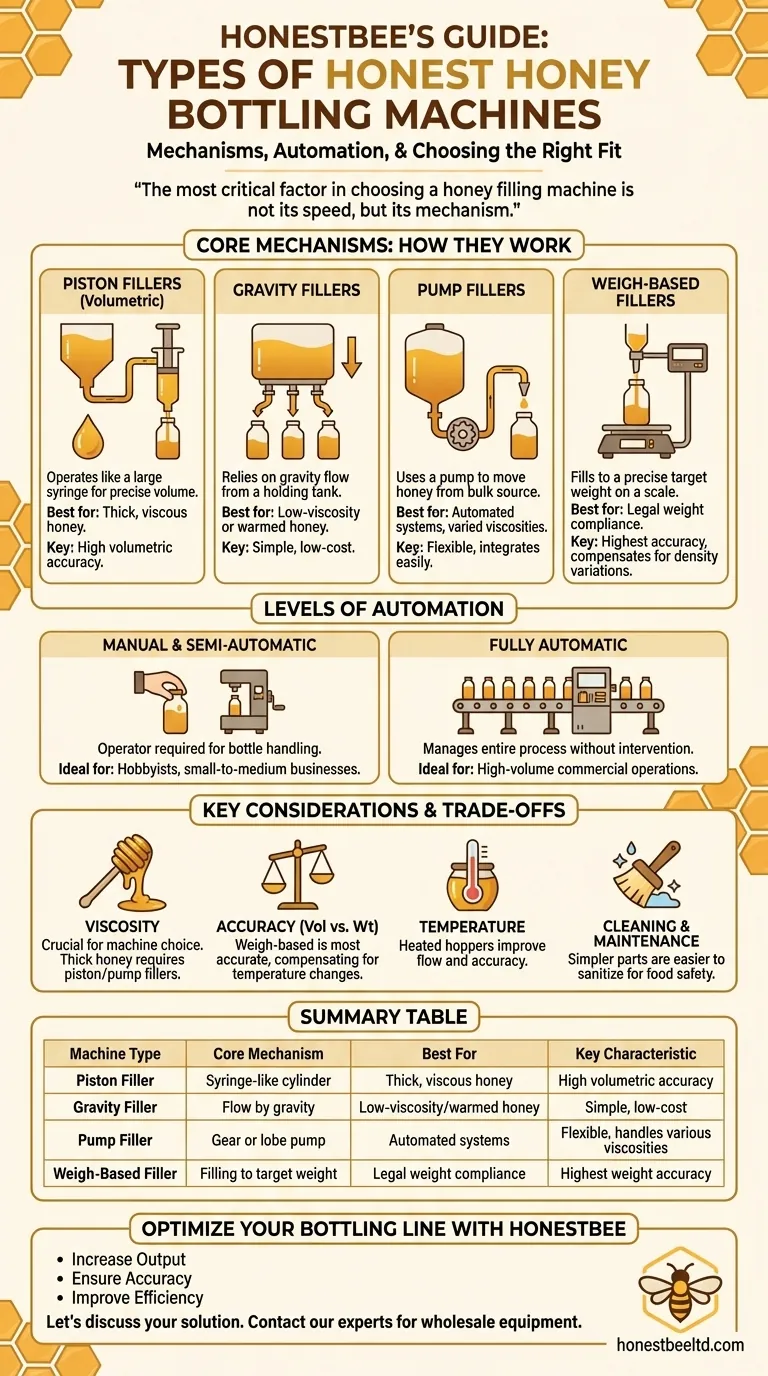At their core, honey bottling machines are distinguished by their filling mechanism, not just their level of automation. The primary types are piston fillers (volumetric), gravity fillers, pump fillers, and weigh-based fillers. Each is designed to handle honey's unique viscosity and meet different production scales, from small hobbyist setups to large commercial operations.
The most critical factor in choosing a honey filling machine is not its speed, but its mechanism. Your honey's viscosity and your required fill accuracy (by volume or weight) will determine whether a piston, gravity, pump, or weigh-based filler is the right tool for your operation.

How Honey Filling Machines Work: The Core Mechanisms
Understanding the method each machine uses to dispense honey is the key to selecting the correct one. The mechanism dictates the machine's suitability for different honey types and production volumes.
Piston Fillers (Volumetric Filling)
A piston filler is one of the most common and effective types for honey. It operates like a large syringe, drawing a precise amount of honey into a cylinder and then pushing that exact volume into the container.
This method is highly accurate for volumetric filling and is especially well-suited for thick, viscous products like honey.
Gravity Fillers
A gravity filler is the simplest mechanism. It consists of a holding tank positioned above the filling nozzles. When a valve opens, gravity causes the honey to flow down into the bottles.
These are best for lower-viscosity or warmed honey and are typically used in manual or semi-automatic setups for small-scale beekeepers due to their simplicity and lower cost.
Pump Fillers
Pump fillers use a pump (such as a gear or lobe pump) to move honey from a bulk tank through the filling nozzles. The amount of product dispensed can be controlled by the timing of the pump's operation.
This type is very flexible, can handle a wide range of viscosities, and is easily integrated into automated systems where honey is drawn from large drums or tanks.
Weigh-Based Fillers
Also known as weighing filling machines, these systems fill containers to a precise target weight rather than a volume. Each bottling station sits on a load cell or scale.
The filler dispenses honey until the scale registers the correct weight, then shuts off the flow. This is the most accurate method, as it compensates for any variations in honey density caused by temperature changes or air bubbles.
Choosing Your Level of Automation
The filling mechanisms above can be integrated into systems with varying degrees of automation, which directly impacts labor costs, speed, and initial investment.
Manual & Semi-Automatic Systems
Manual systems require an operator to place the bottle, activate the fill, and remove the bottle. Semi-automatic systems might automate the filling process itself, but still require an operator to manually handle the containers.
These are ideal for hobbyists and small-to-medium businesses where production volume doesn't justify the cost of full automation.
Fully Automatic Systems
A fully automatic system manages the entire process. Conveyors move bottles into place, sensors trigger the fill, and the filled bottles are moved downstream for capping and labeling without operator intervention.
These machines are built for high-volume commercial operations where efficiency, consistency, and scalability are the primary goals.
Understanding the Trade-offs and Key Considerations
Choosing a machine involves more than just picking a type. Several factors will dictate your success.
Viscosity is Everything
Honey's thickness is the single most important consideration. A thick, crystallized honey will clog a simple gravity filler but can be handled easily by a powerful piston or pump filler.
Accuracy: Volume vs. Weight
Honey is legally sold by weight, not volume. While volumetric fillers (like piston machines) are very consistent, any change in honey's temperature will alter its density, changing the final weight. Weigh-based fillers eliminate this issue, ensuring every bottle meets its label weight.
Temperature Control
Honey flows much more easily when it is warm. Many professional-grade honey fillers incorporate a heated hopper or tank to keep the honey at a consistent, workable temperature, which improves both speed and accuracy.
Cleaning and Maintenance
Honey is sticky and can be difficult to clean. Consider how easily a machine can be disassembled and sanitized. Systems with fewer complex parts are generally easier to maintain, which is a critical factor for food safety.
Making the Right Choice for Your Operation
Your ideal machine depends entirely on your scale, product, and goals.
- If you are a hobbyist or small-scale producer: A manual gravity filler or a small, tabletop manual piston filler offers the best balance of affordability and control.
- If you are a growing mid-sized business: A semi-automatic piston filler or pump filler provides a significant boost in efficiency and consistency over manual methods.
- If you are a large commercial operation: A fully automatic line, likely using a rotary piston filler or a multi-head weigh filler, is necessary to meet high production demands.
- If your product's final weight accuracy is paramount: A weigh-based filling system is the only choice to guarantee legal compliance and prevent product giveaway.
By understanding these core principles, you can confidently select the machine that serves as a foundation for your business's growth.
Summary Table:
| Machine Type | Core Mechanism | Best For | Key Characteristic |
|---|---|---|---|
| Piston Filler | Syringe-like cylinder | Thick, viscous honey | High volumetric accuracy |
| Gravity Filler | Flow by gravity | Low-viscosity/warmed honey | Simple, low-cost |
| Pump Filler | Gear or lobe pump | Automated systems | Flexible, handles various viscosities |
| Weigh-Based Filler | Filling to target weight | Legal weight compliance | Highest weight accuracy |
Ready to Optimize Your Honey Bottling Line?
Choosing the right equipment is the foundation of an efficient and profitable operation. HONESTBEE supplies commercial apiaries and beekeeping equipment distributors with the robust, high-performance bottling machines they need to scale.
We help you:
- Increase Output with machines matched to your production volume.
- Ensure Accuracy with fillers designed for honey's unique properties.
- Improve Efficiency by reducing labor and minimizing product waste.
Let's discuss the best solution for your business. Contact our experts today for a personalized consultation on our wholesale-focused honey bottling equipment.
Visual Guide

Related Products
- Pneumatic Double Nozzle Honey Filling Bottling Packaging Machine
- Fully Automatic Honey Filling Packaging Machine for Processing Line
- Semi Automatic Small Honey Bottle Filling Machine Honey Filler
- Manual Honey Filling Machine Bottling Machine for Honey
- Double Nozzle Small Honey Filling Machine Honey Sachet Packing Packaging Equipment
People Also Ask
- What are the different types of honey fillers? A Guide to Manual, Semi & Fully-Automatic Fillers
- What bottling equipment is used after honey filtering? Choose the Right System for Your Scale
- What are the benefits of using a honey filler? Boost Bottling Speed, Consistency & Brand Appeal
- What temperature for bottling honey? Master the Perfect 49°C (120°F) for Quality & Flow
- What is the filling accuracy of an automatic honey filling machine? Achieve ±0.5% Precision for Your Apiary



















